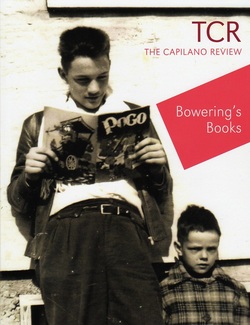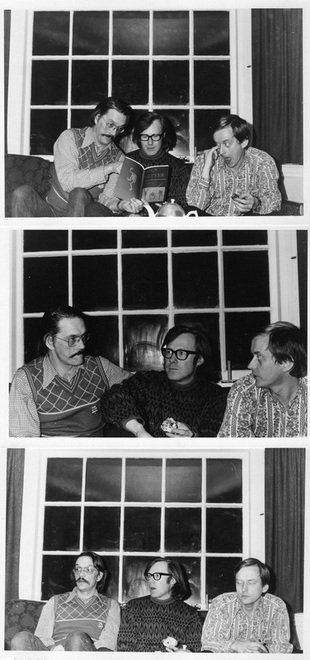
The editors’ invitation to potential contributors to this now obvious festschrift announced its title and asked them to write about one of “Bowering’s books.” The request seemed to be a nod to the poststructuralist principle that texts transcend their authors – arguably a good move when planning an issue on someone whose celebrity and lively personality both compete with his writing. However, if that was the plan, it didn’t work, either for many of the contributors or the editors. But the result is still a fascinating collection, and at a bargain price.
Many of the contributors offer pieces that are as much about George as they are of the books he has written. Four offer tribute texts (five if one includes Steve McCaffery’s pataphysical essay on Allophanes, and six if one includes Douglas Barbour’s flarf-like assemblage of sentences from Errata). The editors themselves scatter 18 often full-page Bowering photographs. True, there are books in many of these, but each is about Bowering’s owning or his reading of them -- as on the issue cover, not about the book per se. And they scatter photographs of 20 of actual Bowering books. So we will have to wait a while longer for a journal issue or book that is strictly about “Bowering’s Books.” It can be complicated being a living author – though usually much better than the alternative.
Does this mixing of focuses matter? Not really, Bowering is as interesting in person as his books are when being read (that’s a tribute too). Moreover, the two interviews with him that contributors have provided (Colin Browne, Miriam Nichols), while necessarily providing Bowering with opportunities to display his mischievous charm and wit, when with Browne more so than with Nichols, also establish important details about many of those books. The anecdotes that others recount about editing or printing or just being with George and books also provide book-relevant detail, if only en passant. So we still get as well as an engagingly friendly collection numerous views or glimpses of those created, read or acquired books.
About George and books, one strong message this large collection conveys concerns his attachment to quantity. “My book is bigger than your book,” Robert Kroetsch infamously wrote in concluding Neuman & Kamboureli’s feminist
This special issue of TCR – our largest yet – pays tribute to the mercurial and inestimable genius of
George Bowering.
George summons big numbers. In fifty years of publishing he has seen over a hundred books
into print by over sixty different publishers. (5)
In beginning his interview/conversation with Miriam Nichols, Bowering is careful to establish from the outset that he and some others in Vancouver were reading many of the poets in Don Allen’s The New American Poetry several years before the anthology appeared – “there were lots and lots of interesting books coming out by people like Allen Ginsberg and Jack Kerouac and Michael McClure. There was all kinds of stuff, but when the New American Poetry anthology came out in 1960, it wasn’t a sudden nova. It was, “Oh! here’s all the guys that we like gathered in one volume” (148). Near the beginning of his interview by Browne he exclaims about his now dispersed 37th Avenue home library: “I got rid of ten thousand books, right?” “I had one room whose bookshelves had only William Carlos Williams, Ezra Pound, Gertrude Stein, and H.D. That’s all there was in that whole room. But there were a lot of them!” (11). About writing his two westerns (1988 and 1994) he says (inflating at least his age) “I had read a thousand westerns when I was a kid but I but I hadn’t read a western for fifty years – I went and read a whole pile of westerns” (19). The Browne interview is aimed at compiling Bowering’s 50 essential books for a library, but Bowering keeps listing books and authors from all over the world that he has read but can’t include, finally exclaiming
Gosh! Jeez. Names tumble through my head now. [Laughter]. What about Lady Murasaki. We didn’t
even mention Dhusvam Sayami.
CB: We’re slying sneaking in more names here at the end.
GB: Yes. Georges Perec! Italo Calvino! Gosh! What’s his name that starts with Q? There’s so many of
them. John Berger – the list just goes on and on. (25)
In her contribution to the volume, Margaret Atwood comments that in the Bowering book she has obediently chosen to write about, The Gangs of Kosmos, there are “[n]o silly duck walks in the poems; those were done by his bodyguard, at parties, and for faking his own biography from time to time. All writers keep a double in store so they can save the reality for the art, and George’s double was just more obvious than most” (62). It’s a slightly less kind argument than mine for writing less about the Bowering persona and more about those ever accumulating books. It also suggests that it could well have been George’s double that was hamming up the names and numbers for Colin Browne. Gosh! Jeez! Why not. But people also choose their doubles, if they choose to have one, and that choice says something about them. George’s usually says I want to be liked but I don’t always enjoy being close or vulnerable. I’ve never minded that about him.
There is also a second double that makes an early appearance in this collection. This is the institutional Bowering, being created to replace eventually the biological one: the George Bowering Library at Capilano University, erstwhile home of TCR. Ten pages here present it, six in colour. The photos suggest an ultra serious Bowering, high slim arches and tiled medieval floors, more a chapel than a Gosh! Jeez! hangout. Perhaps a Grail chapel. It is being created somewhat earlier in the writer’s career than the University of Toronto’s E.J. Pratt Library, the Al Purdy A-frame Trust, or York University’s Clara Thomas Archives and Special Collections – all of them both useful places and reminders of time’s passage.
 Bowering, myself, and David McFadden, fall 1973 at my house in Toronto. Photos by Linda Davey.
Bowering, myself, and David McFadden, fall 1973 at my house in Toronto. Photos by Linda Davey. The penultimate George photo in the book was taken in late 1973 in my living room at 395 Elm Road on the boundary between Toronto and North York. George, David McFadden, and I are looking at the Fall 1973 issue of Open Letter (Second Series, Number 6), probably – judging by where the issue is open – at bpNichol’s interview of Raoul Duguay, with George dramatizing an I-told-you-so response. The photo was taken by my late partner Linda, not by Angela Bowering in 1970 as the caption states. I no longer have the ski sweater but I do still have the negatives and companion prints from that roll of film – with George pretending various other theatrical responses, including anger and shock, and David seemingly bored. Well, you can’t duck walk on a crowded sofa. But Linda was entertained enough to keep photographing. The top photo here is the one reproduced in Bowering’s Books, the ones below from my archives. Angela never visited us in that house, unfortunately (she did once visit our next house, near Casa Loma – in 1984 during the Longliners Conference). I wish she had – she was often as much fun as George – thoughts I might not be having, or including here, if this were only a journal issue on books.
FD
 RSS Feed
RSS Feed